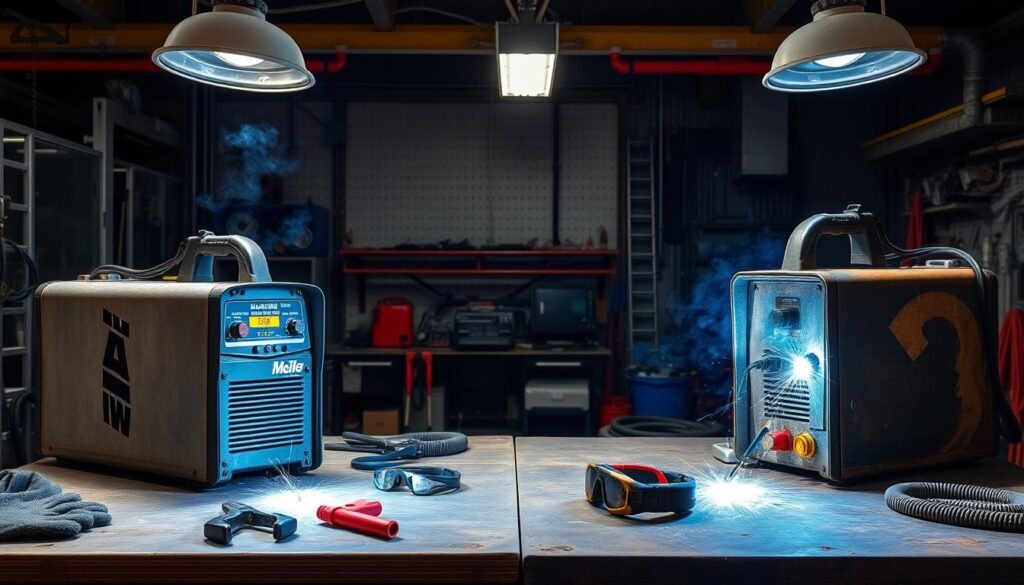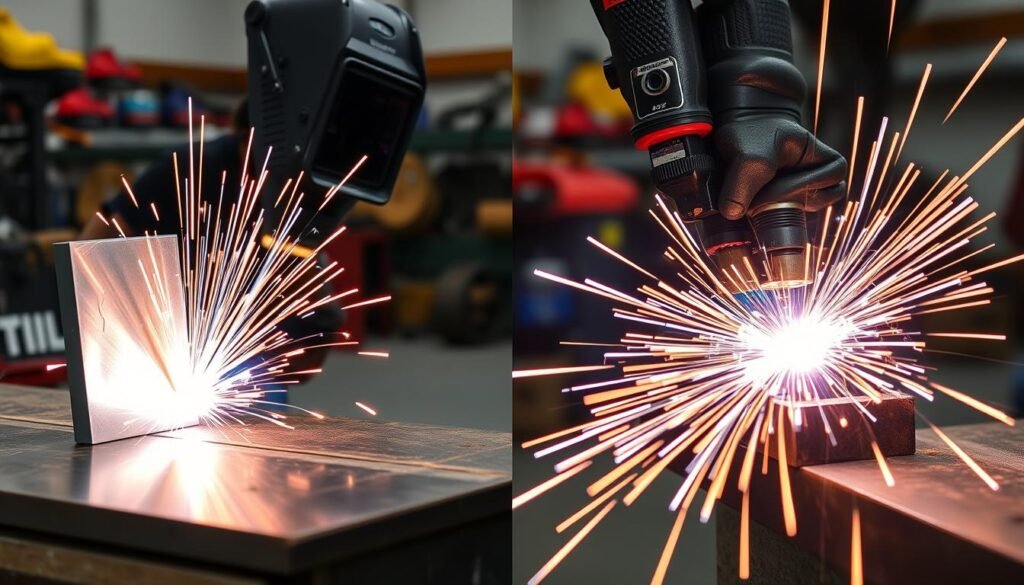لحام المعادن هو جزء أساسي من صناعة الأشياء، لكنه أصعب مع مواد مختلفة مثل الألمنيوم والفولاذ. الحرفيون المهرة يعرفون أن كل معدن يحتاج إلى طرق خاصة ومعرفة عميقة بخصائصه لتحقيق أفضل النتائج.
لحام الألمنيوم والفولاذ يتطلب طرقًا مختلفة بسبب اختلاف موصلية الحرارة ونقاط الانصهار والهياكل. يجب أن تتناسب تقنيات اللحام مع احتياجات كل مادة لضمان أن يكون الوصل قويًا ويعمل بشكل جيد.
من المهم للمهندسين والمصنعين وعمال المعادن أن يعرفوا الاختلافات الرئيسية في لحام الألمنيوم والفولاذ. تساعدهم هذه المعرفة على استخدام طرق الانضمام الصحيحة لتحقيق نتائج دقيقة وموثوقة.
النقاط الرئيسية
- الألمنيوم والصلب يواجهان تحديات لحام مختلفة
- خصائص المادة تؤثر بشكل كبير على تقنيات اللحام
- تختلف الموصلية الحرارية بين المعادن المختلفة
- يتطلب كل مادة معدات متخصصة
- المعرفة الشاملة تضمن نجاح لحام المعادن
مقدمة في أساسيات لحام المعادن
اللحام هو عملية تصنيع رئيسية. يحول المواد الخام إلى هياكل معقدة من خلال دمج المعادن. معرفة أساسيات اللحام تساعد على إنشاء روابط قوية بين المعادن.
اللحام هو فن وعلم في آن واحد. يتطلب مزيجًا من المعرفة العلمية والمهارات العملية. يحتاج اللحامون إلى فهم مبادئ اللحام المعقدة لربط المعادن بنجاح.
المبادئ الأساسية لدمج المعادن
الاندماج المعدني ينطوي على عدة تفاعلات مهمة:
- التحكم الدقيق في درجة الحرارة لتحقيق التحول الأمثل للمادة
- فهم خصائص المواد الفريدة لمختلف المعادن
- اختيار تقنيات اللحام المناسبة استنادًا إلى المتطلبات المحددة
فهم خصائص المادة
كل معدن له خصائصه الخاصة التي تؤثر على اللحام. تشمل الخصائص المهمة:
| العقار | تأثير على اللحام |
|---|---|
| التوصيل الحراري | يحدد توزيع الحرارة أثناء اللحام |
| نقطة الانصهار | يحدد الطاقة المطلوبة لدمج المعدن |
| الهيكل المعدني | يؤثر على قوة اللحام والمتانة |
دور التحكم في درجة الحرارة
التحكم في درجة الحرارة ضروري في اللحام. تطبيق الحرارة الدقيق يضمن دمج المعدن بشكل مثالي دون الإضرار بسلامة المادة.
إتقان التحكم في درجة الحرارة هو حجر الزاوية في الحرفية الاستثنائية في اللحام. – جمعية اللحام المحترفة
يجب على خبراء اللحام أن يتعلموا إدارة الحرارة بشكل جيد. هذا يحمي المادة أثناء إنشاء روابط قوية.
خصائص المادة: الألمنيوم مقابل الصلب
من المهم معرفة الصفات الخاصة للألمنيوم والصلب من أجل لحام جيد. هذه المعادن لها خصائص مختلفة تؤثر على طريقة لحامها وأدائها.
الألمنيوم والصلب يختلفان في العديد من الطرق. الألمنيوم خفيف ويوصل الحرارة بشكل جيد. الصلب قوي ويستمر لفترة أطول.
- موصلية الألمنيوم الحرارية: حوالي 237 واط/متر كلفن
- موصلية حرارية للصلب: حوالي 50 واط/متر كلفن
- نقطة انصهار الألمنيوم: 660°C (1220°F)
- نقطة انصهار الصلب: 1370°C (2500°F)
“فهم خصائص المادة هو أساس تقنيات اللحام الفعالة.” – خبراء هندسة اللحام
الألمنيوم والفولاذ يواجهان تحديات مختلفة في اللحام. نقطة انصهار الألمنيوم المنخفضة وموصلية الحرارة العالية تتطلب طرقًا خاصة. هذا يساعد على تجنب التشوه ويضمن اتصالًا جيدًا.
| العقار | ألمنيوم | فولاذ |
|---|---|---|
| الكثافة | 2.7 جم/سم³ | 7.85 جم/سم³ |
| نسبة القوة إلى الوزن | مرتفع | مرتفع جدًا |
| مقاومة التآكل | ممتاز | معتدل |
يجب على خبراء اللحام أن يفكروا في هذه الخصائص لاختيار الطرق والأدوات المناسبة لكل معدن.
كيف يختلف اللحام بالألمنيوم عن اللحام بالصلب
لحام الألمنيوم والفولاذ يختلف ويحتاج إلى مهارات وأساليب خاصة. معرفة الاختلافات الرئيسية بين هذين المعدنين هي المفتاح لإجراء لحامات جيدة في العديد من الصناعات.
تغيرات في التوصيل الحراري
الألمنيوم والصلب لهما موصلية حرارية مختلفة. يؤثر ذلك على طريقة لحمهما. يسخن الألمنيوم بشكل أسرع، مما يجعل لحامه أكثر تحديًا.
يجب على اللحامين تعديل طرقهم لتجنب الالتواء أو التشويه. وذلك لأن الألمنيوم ينشر الحرارة بسرعة.
- الألمنيوم ينقل الحرارة تقريبًا بخمس مرات أسرع من الصلب
- يجب على اللحامين استخدام مدخلات حرارة أقل لعملية لحام الألمنيوم
- تقنيات التبريد المتخصصة غالبًا ما تكون ضرورية
اعتبارات طبقة الأكسيد
التعامل مع طبقة أكسيد الألمنيوم يمثل تحديًا كبيرًا. على عكس الفولاذ، يمتلك الألمنيوم أكسيدًا سميكًا وواقياً. يجب تنظيف هذه الطبقة جيدًا قبل اللحام.
هذه الطبقة الأكسيدية لها نقطة انصهار عالية. تجعل لحام الألمنيوم أمرًا معقدًا جدًا.
"طبقة الأكسيد في لحام الألمنيوم مثل ضيف غير مدعو يعقد العملية بأكملها." – محترف في اللحام
عوامل القوة والمتانة
قوة اللحام تختلف بين الألمنيوم والفولاذ. الفولاذ عادة أقوى. لكن، الألمنيوم يحتاج إلى تقنية دقيقة لمضاهاة قوة الفولاذ.
اختيار المعالجة الحرارية ومواد الحشو مهم أيضًا. فهي تؤثر على متانة اللحام.
| خاصية | لحام الألمنيوم | لحام الصلب |
|---|---|---|
| متوسط قوة اللحام | 60-70% من المعدن الأساسي | 80-90% من المعدن الأساسي |
| مادة حشو نموذجية | سبائك 4043 أو 5356 | ER70S-6 |
يحتاج اللحامون إلى تعديل طرقهم لكل مادة. هذا يضمن أفضل النتائج لكل من الألمنيوم والصلب.
المعدات والأدوات الأساسية لكل مادة
اختيار معدات اللحام المناسبة هو المفتاح لمشاريع ناجحة مع الألمنيوم والفولاذ. كل مادة تحتاج أدواتها الخاصة لتحقيق أفضل النتائج. معرفة متطلبات كل معدن تساعد اللحامين على اختيار الآلات والإكسسوارات المناسبة.

أدوات لحام الألمنيوم تحتاج إلى عناية خاصة بسبب خصائصه الفريدة. يجب على اللحامين استخدام معدات دقيقة يمكنها التعامل مع نقطة انصهاره المنخفضة ونقله الحراري العالي.
- لحامو TIG مع تحكم متقدم في درجة الحرارة
- قضبان تعبئة الألمنيوم المتخصصة
- مصادر طاقة التيار المتردد عالية التردد
- أنظمة غازات الحماية من الأرجون
أدوات لحام الصلب، من ناحية أخرى، تحتاج إلى آلات لحام قوية ومرنة. يجب أن تتعامل هذه الآلات مع درجات حرارة عالية ومواد كثيفة.
- آلات اللحام بالمقاومة الكهربائية (MIG) ذات التيار الأعلى
- معدات اللحام بخيوط التدفق
- أنظمة الحماية بغاز ثاني أكسيد الكربون أو الغاز المختلط
- مواد تعبئة فولاذية عالية التحمل
"الأدوات الصحيحة تُحدث فرقًا كبيرًا في تحقيق لحامات نظيفة وقوية." – جمعية اللحام المهنية
معدات الحماية ضرورية لجميع عمليات اللحام، بغض النظر عن المادة. يجب على اللحامين ارتداء معدات أمان عالية الجودة لتجنب الإصابات.
- خوذات اللحام ذاتية التعتيم
- قفازات جلد مقاومة للهب
- سترات اللحام والأرواب
- نظارات السلامة بدرجات الظل المناسبة
اختيار معدات اللحام المناسبة للألمنيوم أو الصلب يضمن الدقة والسلامة وجودة اللحام العالية.
تحضير الأسطح: اللحام بالألمنيوم مقابل الصلب
تحضير الأسطح هو المفتاح للحصول على لحامات عالية الجودة. يعرف اللحامون أن تنظيف وتحضير السطح بشكل جيد أمر حاسم. يؤثر على جودة اللحام ومدى قوة الوصل.
متطلبات التنظيف لتحقيق أداء لحام مثالي
تنظيف المعدن بشكل صحيح مهم لتجنب اللحامات الضعيفة. كل معدن يحتاج إلى طريقة تنظيف خاصة به:
- الألمنيوم يحتاج إلى تنظيف عميق للتخلص من طبقات الأكسيد
- يجب إزالة الصدأ والقشور من الفولاذ
- استخدام المذيبات هو الأفضل للتنظيف الأول
طرق تحضير الحافة الدقيقة
كيفية تحضير الحواف أمر حيوي لنجاح اللحام. تعتمد الطريقة الصحيحة على سمك المعدن وتصميم الوصلة:
- تحديد الحواف للمعادن الأثقل
- طحن لأسطح ناعمة ونظيفة
- فحص قياسات الفجوة بعناية
استراتيجيات التسخين المسبق لمعادن مختلفة
يساعد التسخين المسبق على إدارة إجهاد الحرارة ويعزز اختراق اللحام. عادةً ما يحتاج الألمنيوم إلى تسخين مسبق أقل من الفولاذمن المهم التحكم في درجة الحرارة لتجنب تشويه المادة.
"التحضير السطحي الصحيح هو 50% لنجاح اللحام" – جمعية اللحام المهنية
كل معدن يحتاج لمسة خاصة لتحضير السطح. هذا يضمن أن يكون اللحام قويًا ويعمل بشكل جيد.
تقنيات اللحام الشائعة لكل من المواد
الانضمام المعدني هو المفتاح في صناعة الأشياء وبناء الهياكل. يستخدم اللحامون العديد من التقنيات للعمل مع الألمنيوم والفولاذ. معرفة هذه الطرق تساعد على إنشاء روابط معدنية قوية.

- لحام TIG: طريقة دقيقة للوصلات عالية الجودة
- اللحام بالمقاومة الكهربائية: تقنية سريعة ومتعددة الاستخدامات
- اللحام بالقوس الثابت: الطريقة التقليدية للبيئات الصعبة
كل تقنية لها قوتها الخاصة للمعادن والمشاريع المختلفة. اللحام بالتقنية TIG ممتاز للأعمال التفصيلية. اللحام بالتقنية MIG هو الأفضل للإنتاج السريع.
| تقنية اللحام | أداء الألمنيوم | أداء الصلب |
|---|---|---|
| لحام القوس التنغستنّي (TIG) | دقة ممتازة | مناسب للمواد الرقيقة |
| اللحام بالمقاومة الكهربائية | فعالية معتدلة | إنتاجية عالية |
| اللحام بالقصدير | تطبيق محدود | أداء خارجي قوي |
اختيار تقنية اللحام المناسبة يعتمد على العديد من العوامل. وتشمل هذه سمك المادة، والبيئة، والجودة المطلوبة. يجب على اللحامين اختيار أفضل طريقة بناءً على احتياجات المشروع.
إتقان تقنيات اللحام المتعددة ضروري لإنشاء روابط معدنية قوية وموثوقة. – جمعية اللحام المهنية
يعرف اللحامون أن تقنية واحدة لا تناسب الجميع. القدرة على التكيف ومعرفة العديد من التقنيات أمر حاسم للنجاح.
منع العيوب الشائعة في اللحام
عيوب اللحام يمكن أن تضعف المفاصل المعدنية. من المهم معرفة كيفية تجنب هذه المشاكل. هذا صحيح لكل من الألمنيوم والفولاذ.
التحديات الخاصة بالألمنيوم
لحام الألمنيوم أمر معقد. لديه انتشار حراري عالي وطبقة أكسيد تفاعلية. هذه تحتاج إلى عناية خاصة لتجنب العيوب.
- المسامية: مشكلة كبيرة في لحام الألمنيوم بسبب الهيدروجين
- التكسير: عرضة للإجهاد الحراري بسبب نقطة انصهاره المنخفضة
- تداخل طبقة الأكسيد: يحتاج إلى تنظيف شامل قبل اللحام
مشاكل متعلقة بالفولاذ
يواجه لحام الصلب مجموعته الخاصة من العيوب. يمكن أن تؤثر هذه على جودة وقوة اللحام. من الضروري فحص اللحامات لهذه المشاكل.
| نوع العيب | سبب | استراتيجية الوقاية |
|---|---|---|
| تشويه | توزيع غير متساوٍ للحرارة | تسلسل اللحام المُتحكم |
| التكسير | محتوى عالي من الكربون | التحكم الدقيق في درجة الحرارة |
| المسامية | الغاز المحبوس أثناء التصلب | تقنيات الحماية الصحيحة |
إجراءات مراقبة الجودة
يمكن للتحكم في الجودة الجيد أن يقلل من عيوب اللحام. تساعد أدوات مثل الاختبار بالموجات فوق الصوتية والأشعة السينية في اكتشاف المشاكل مبكرًا. هذا يحافظ على قوة الهيكل.
"الدقة في اللحام ليست صدفة، بل نتيجة للتحضير الدقيق والتنفيذ المهاري." – خبير صناعة اللحام
مراقبة الجودة تتعلق بالتفاصيل. فهي تشمل التحضير السطحي الصحيح، التقنية الدقيقة، الأدوات المناسبة، والفحص الدقيق. هذا يضمن أفضل النتائج.
الاعتبارات السلامة للمواد المختلفة
السلامة في اللحام هي المفتاح عند العمل مع معادن مثل الألمنيوم والصلب. يحتاج اللحامون إلى ارتداء المعدات المناسبة ومعرفة مخاطر السلامة لكل مادة.
- اختيار معدات الحماية الشاملة
- تقنيات فعالة لاستخراج الدخان
- استراتيجيات قوية للوقاية من الحرائق
- بروتوكولات السلامة الكهربائية الصارمة
اللحام بالألمنيوم يأتي مع مجموعة من التحديات الخاصة به. يحتاج إلى معدات حماية خاصة. يشمل ذلك ملابس مقاومة للهب، خوذات ذاتية التعتيم، وقفازات سميكة لتجنب الحروق والإشعاع.
“السلامة ليست غالية، إنها لا تقدر بثمن” – لحام غير معروف
عند لحام الألمنيوم، يُعد استخراج الدخان أمرًا حاسمًا. يطلق الألمنيوم أبخرة أكثر سمية من الصلب. التهوية الجيدة ومعدات التنفس هي المفتاح للبقاء آمنًا.
السلامة الكهربائية تختلف بين الألمنيوم والصلب. الألمنيوم يوصل الكهرباء بشكل أفضل، لذلك يحتاج إلى تأريض وعزل أفضل. يجب على اللحامين استخدام المعدات المناسبة لكل مادة لتجنب المخاطر الكهربائية.
الوقاية من الحرائق تختلف أيضًا حسب المادة. عادةً ما يحتاج لحام الصلب إلى حواجز نارية أساسية. لكن اللحام بالألمنيوم يتطلب حماية أكثر تقدمًا بسبب انخفاض نقطة انصهاره وسلوكه الفريد في الاحتراق.
- استخدم ستائر اللحام المقاومة للحريق
- احتفظ بطفايات الحريق بالقرب منك
- مسح مساحة العمل من المواد القابلة للاشتعال
- ارتدِ ملابس مقاومة للهب مناسبة
بالنسبة للحرفيين المحترفين في اللحام، السلامة ليست اختيارية. إنها ضرورية للعمل المعدني الجيد. يحتاجون إلى تدريب مستمر، وأحدث المعدات، ومعرفة جيدة بموادهم من أجل السلامة.
الخاتمة
لحام الألمنيوم والفولاذ يُظهر لنا مدى تعقيده. اختيار المادة المناسبة يعني النظر في كيفية توصيلها للحرارة وتحضير أسطحها. كل معدن يحتاج إلى طريقة لحام خاصة به للحصول على أفضل النتائج.
تبدأ ممارسات اللحام الجيدة بمعرفة المواد. الألمنيوم لديه نقطة انصهار أقل ويشكل طبقة أكسيد، مما يجعله أصعب في اللحام من الصلب. يحتاج اللحامون إلى تعلم تقنيات محددة واستخدام الأدوات المناسبة لضمان قوة عملهم.
نجاح لحام الألمنيوم أو الصلب يعتمد على المهارة، والأدوات المناسبة، ومعرفة المواد جيدًا. اللحامون الذين يمكنهم العمل مع معادن مختلفة مستعدون لأي تحدٍ. يستمرون في التعلم والممارسة للبقاء في المقدمة في مجالهم.
تحسين مهارات اللحام يعني فهم الاحتياجات والحدود الخاصة بكل مادة. مع التدريب المستمر ومواكبة التكنولوجيا الجديدة، يمكن للحرفيين أن يقوموا بأعمال رائعة في أي مشروع معدني.
